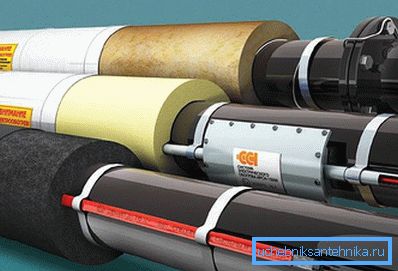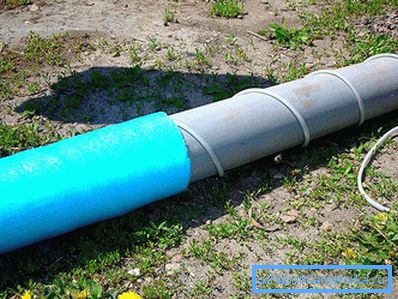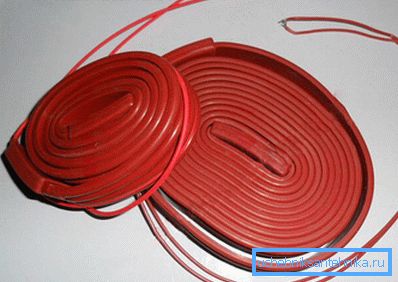Heated sewer pipe cable
When laying the external pipes of the sewerage system, it is recommended to deepen them below the level of soil freezing, but this is not always possible. Here, the characteristics of the ground and the technical features of the system itself may have an impact. If it is impossible to go deeper below the freezing level and there is a high probability of the pipe freezing, it is necessary to provide for the insulation of the sewage system. For this you can use a variety of insulation materials or heating cable. It is about the last version and will be discussed.
Variety of heating cable

Electrical heating cable has a certain resistance. With the passage of current, it heats up and heats the space around it. Heating cables differ in their installation location. Such devices can be placed both outside the pipe and inside it. Many experts recommend using the first method.
Tip! Installation of the heating cable from the inside can only be used in extreme cases.

Electric heating cables themselves are available in several types. Namely:
- Self-regulatory. Such devices are considered the most modern. A self-regulating cable can change its resistance (and, therefore, the degree of heating) depending on the ambient temperature. And in some areas at the same time there can be different resistance. This feature makes it possible to significantly save on electricity;
- Resistive. The cheapest type of heating cable. It is heated throughout the length with the same degree. So that the device does not burn out from overheating, it is necessary to install temperature sensors;
- Zonal is an analogue of resistive heating cable. Their difference is that the zonal is heated only in certain areas, this makes it possible to cut it into pieces and insulate certain parts of the sewer system. The zone cable, as well as the previous one, needs the installation of a thermal sensor.

Also, cables are divided by their power. As a rule, for systems of the sewerage use products with a power of 33 W per linear meter.
Warming outside

To equip sewer pipes with an external heating cable, it is necessary to prepare adhesive tape. It can be used to attach the cable to the surface. Most of these devices have a polymeric protective shell, so you can not use metal fasteners.
Tip! If the pipe is made of polymers, then it should be prepared before installation work. The entire outer surface must be wrapped with foil tape. Such an aluminum layer will allow uniform heating of the entire pipe.
The very progress of the installation of the electric heating cable is as follows:
- The cable is laid out along the pipe, and several parallel threads can be used. This installation is considered the most desirable. If the length of the cable allows, then (if necessary) it can be screwed onto the pipe in the form of a spiral.
- Fixed using adhesive aluminum or other heat-resistant tape. At the same time it is necessary to ensure a tight fit of the cable to the pipe.
- At the joints of pipes, the cable is laid in a loop (1.5 meters), so that in the future it can be disconnected without dismantling the heating.
- Thermal sensors are attached to the pipe in parallel with the cable (if non-self-regulating devices are used).
- After installation, the insulation material is laid. At the same time, it is necessary to provide reliable protection against moisture ingress, therefore after the insulation a layer of waterproofing material is laid.
Tip! When laying an electric heating cable, it is not allowed to cross its wires, especially for resistive devices.
After installing the insulating material, it is desirable to mark the location of the cable, so the risk of damage during repair work will be reduced.
Warming sewage inside

There are cases when the electrical heating cable can be placed only inside. For example, if the system has already been created and the need for heating became clear later (with the onset of cold weather). This arrangement has some drawbacks. Namely:
- to some extent decreases the diameter of the pipe;
- increased risk of blockages;
- short circuit of the cable itself may occur;
- if the system has twists and turns, it will be very difficult to evenly place the heating element inside it.
The process of laying the cable looks like this:
- the system is mounted a special tee coupling;
- then the cable is inserted into the pipe itself;
- after that, the tee is sealed and the power cable is connected.
As a rule, this method is used only when dealing with ice jams that have already formed. In this case, inserting the cable inside the pipe will quickly fix the problem.
Some recommendations for the installation and use of cable

When carrying out installation and further operation of an electric heating cable, it is worth adhering to some recommendations of experts. Namely:
- the length of one cable thread should not exceed 80 meters;
- Before installing the insulating material, check the entire structure for operability;
- It is not allowed to turn on the electric heating cable if it is laid in a coil;
- the cable itself can be connected to a regular outlet or a separate shield;
- when laying, try not to place the cable on sharp corners;
- Before installation, check pipes for cracks and holes;
- when installing, follow the instructions from the manufacturer, it will help to significantly increase the service life of the heating cable.
It is better to purchase a self-regulating cable. Such devices last longer and help save energy.
Video
This video shows the arrangement of heating sewage, namely the installation of a heating cable on the pipe: